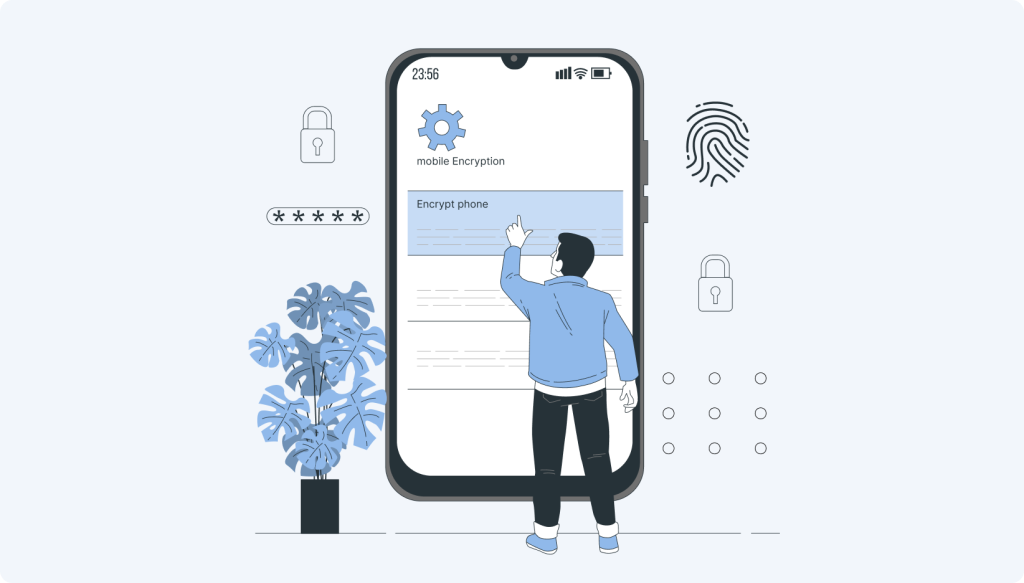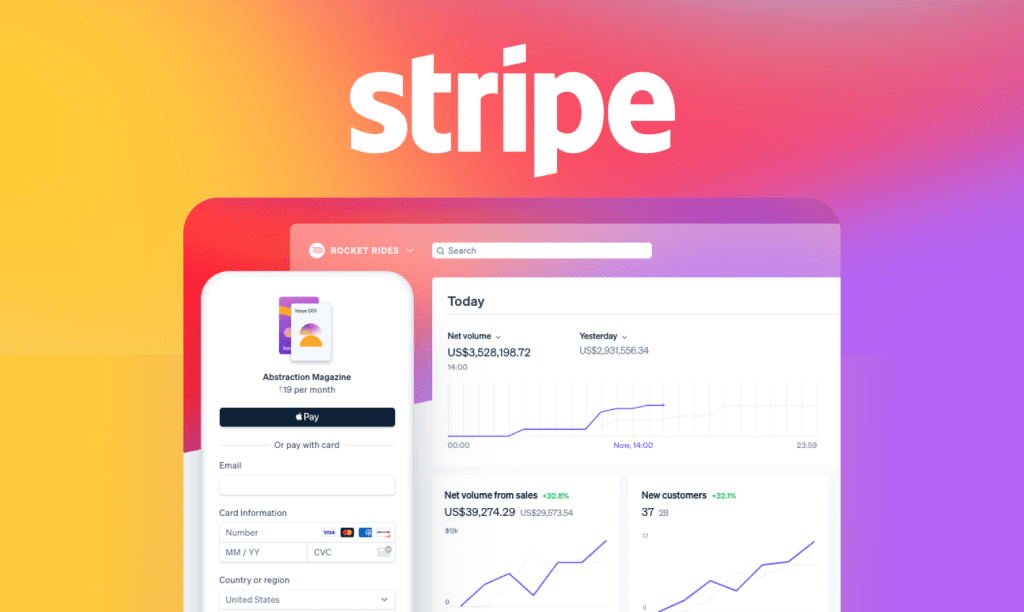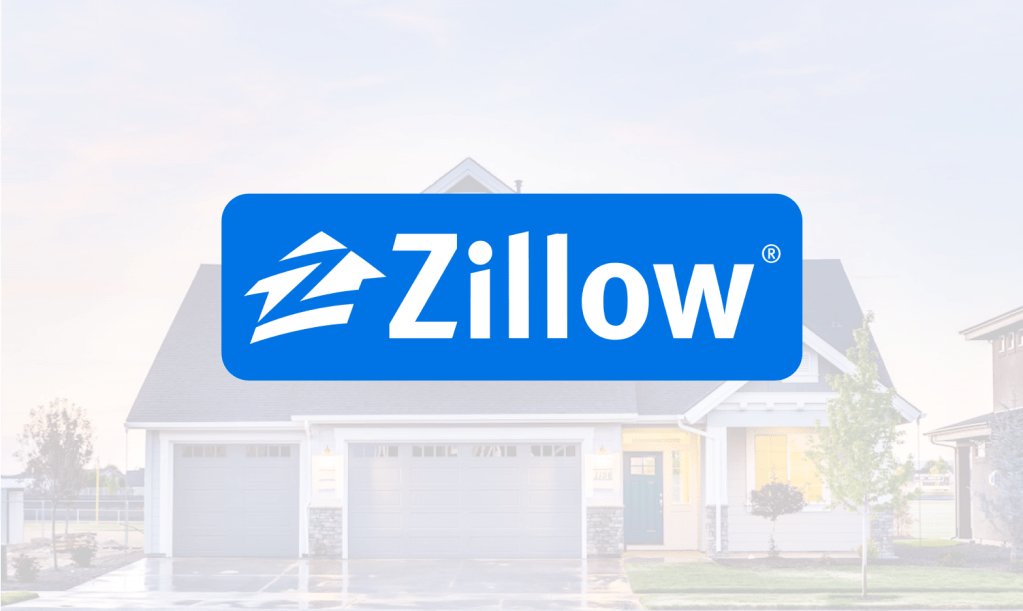As studies have found that iOS users are more likely to make in-app purchases and spend more money on apps than their Android counterparts, no wonder startups choose an iOS platform for their first app development endeavor.
Understanding how much it costs to build an iOS app is essential. In fact, it is one of the first questions asked by clients who approach us with their app idea.
There is no universal formula to estimate the cost of developing an iOS app as it is contingent on numerous factors. This includes:
- Complexity of the app,
- Size of the development team,
- Geographical location of the development team
- Required functionalities.
However, a commonly used method of determining iOS app development costs is to calculate the number of hours required to develop each feature and multiply it by the hourly rate of the development team.
The tentative cost to build a basic iOS app with simple features can range anywhere between $10,000 to $50,000 and can exceed $100,000 for a more complex iOS app with advanced features.
So, what is an actual iOS app development cost? Let’s delve into each factor that affects the cost in detail to land at a more precise estimate.
5 Factors Influencing an iOS App Development Cost
Let’s now take a look at all key factors that impact an ios app development cost:
1. The Complexity Level of App Development
The complexity level of iOS app development is typically determined by various factors, including:
- The number and types of features required in the app,
- The integration of third-party APIs or services
- The complexity of the app’s UI/UX design
- The need for custom backend development or data storage solutions.
The more complex an app is in terms of these factors, the more resources and time it will require to develop, and consequently, the higher the development cost will be.
Here is a comprehensive breakdown of the estimated costs based on the complexity level:
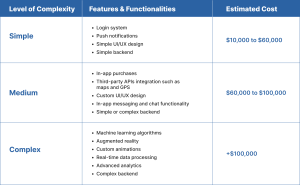
2. The Complexity Level of App Design
The design of the app, including the user interface (UI) and user experience (UX), can influence the cost of development. A complex design with custom animations, graphics and transitions will require more effort and time from the development team, thus escaping the iOS app development costs.
Let’s delve into key factors that determine the complexity of application design:
User Interface (UI)
A simple app with a basic UI may only require a few screens with basic visual elements, such as buttons and text fields. However, a complex app with advanced animations, custom graphics, and complex user flows will require a more sophisticated and intricate UI design.
Today, it’s a must to optimize UI design for a wide range of screen sizes and device orientations, which adds to the development cost.
User Experience (UX)
User experience refers to all aspects of the user’s interaction with the application, including its ease of use, responsiveness, and overall satisfaction of the user with the app’s functionality and performance.
Creating a good UX requires a significant investment of time and resources to dig deeper into the target audience, user behavior and industry trends, which adds to the overall iOS app development cost.
Brand Identity
The app’s design must reflect the brand identity of your company. This requires a deep understanding of your brand and its values, which can add complexity to the design process. Ultimately, increasing the overall iOS app development cost.
Also Read: How Much Does It Cost to Hire an Android App Developer?
3. App Category
The category of the application can also have a significant impact on the iOS app development cost. Certain categories such as gaming, social networking, and e-commerce, which involve complex features, interactivity, and third-party integrations, may require more time and resources to develop, thus increasing the overall cost of development.
On the other hand, simpler app categories such as utilities or lifestyle may have fewer features and simpler designs, requiring less time and resources to develop and therefore, resulting in lower development costs.
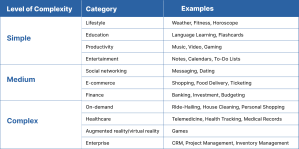
4. Development Team Size
The development team size can vary depending on the project’s scope, complexity, timeline and budget. The rule here is simple: the larger the development team, the higher the cost of building an iOS app.
Typically, a small development team would consist of 2-3 developers, while a larger team could have 5-10 developers or more. The team may also include other key roles such as a project manager, UX/UI designer, quality assurance tester, and technical writer. This can significantly increase the overall iOS app development cost.
Below is a quick overview of how much individual talent charges on an hourly basis:

When it comes to engaging technical experts for your project, you can either work with freelancers or hire a dedicated full-stack iOS app development team from an IT company. As you can analyze from the above individual talent cost breakdown, the former option can be a more costly deal than the latter.
5. Development Team Location
iOS app development is more affordable in some regions than others due to differences in the hourly rates charged by developers
Here’s how much developers from different regions charge on an hourly basis:
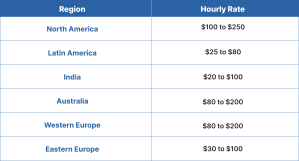
As you can see that developers from North America and Western Europe charge higher rates compared to programmers from India, you can build an app at half the development cost if you choose to work with vendors from India.
The Hidden Costs of iOS App Development
While some of the iOS app development costs are quite apparent, there are hidden costs that you can’t ignore. Let’s have a look:
- App Store Fees: Apple charges a yearly fee of $99 to publish an app on the App Store. This fee is charged regardless of whether the app generates revenue or not.
- Quality Assurance & Accessibility Testing: Once your app is developed, it needs to be rigorously tested to ensure that it delivers a top-notch user experience to all, including people with disabilities. Some vendors may charge additionally for quality assurance & accessibility services.
- Maintenance Plan: After the launch, it’s important to continue updating and maintaining your application to ensure that it remains compatible with new iOS updates and devices. These maintenance costs are typically around 20% of overall app development costs per year.
- Growth Marketing: Even the best iOS app won’t be successful if nobody knows about it. To promote your app and user acquisition, you must invest in growth marketing strategies such as social media advertising, search engine optimization, content marketing and among others.
A Phase-by-Phase Breakdown of the iOS App Development Cost
Any iOS app development project goes through five phases: planning and conceptualization, design, development, deployment and ongoing maintenance. Each phase of an iOS app development can have a significant impact on the overall cost of your project.
Below is a breakdown of the iOS app development cost based on the typical phases of development:
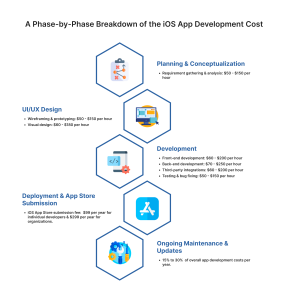
Planning & Conceptualization
During this phase, the primary goal is to gain a comprehensive understanding of your app’s vision and requirements. The aim is to come up with a detailed and actionable project roadmap that encompasses a well-defined timeline and identifies the necessary resources for successful project execution.
UI/UX Design
This stage involves creating wireframes and interactive prototypes to visualize your iOS app’s user interface and user experience. Also, developing the final visual design and assets for your app, which include icons, images, and animations. As the complexity of the design and the required number of screens and required assets increases, the overall iOS app development cost also rises up.
Development
During this stage, front-end developers, back-end developers and QA engineers work together to turn your app vision into a fully-functional iOS app.
- Front-end development: It’s about creating the user interface of the app. The cost varies according to the complexity and number of screens required.
- Back-end development: It involves building server-side components, APIs, and database integration if required. The cost is influenced by the complexity of the back-end infrastructure and integrations.
- Testing and bug fixing: This process involves performing comprehensive QA & performance testing to identify and resolve bugs and ensure app stability.
Deployment and App Store Submission
The cost for deployment and app store submission for your iOS app is usually minimal and included in the overall iOS app development cost.
Ongoing Maintenance & Updates
It involves activities and tasks required to ensure your iOS app’s continued functionality, performance, and reliability after its initial launch. Those activities and tasks generally are bug fixing, compatibility updates, performance optimization, feature enhancements, backend maintenance and security updates.
The cost depends on the maintenance agreement with the development team or company you are working with.
Practical Ways to Reduce iOS App Development Cost
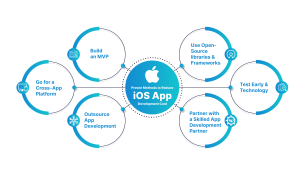
There are many proven ways to effectively manage and cut iOS app development costs for startups while ensuring a high-quality app. Let’s have a look:
Build a Minimal Viable Product (MVP)
Building an MVP can save you 50% or more on overall development costs. An MVP is built with the bare minimum yet must-have features.
Thus, by prioritizing essential features and overlooking unnecessary development, you can significantly reduce costs compared to building a full-fledged application from scratch. This approach also allows you to release a functional version of your app faster.
Also Read: Top MVP Development Companies for Startups & Enterprises
Choose a Cost-Effective Development Approach
If you plan to target multiple platforms in the future, go with a cross-platform development approach. Though the native app development approach offers high performance, tailored user experiences and superior security, it involves building a separate codebase for each platform. This increases development costs and time.
On the other hand, a cross-platform development approach enables you to write code once and deploy it on multiple platforms including iOS and Android. This results in a significant reduction in both development costs and time.
Also Read: Is Flutter Good Cross-Platform Framework for App Development?
Use Open-source Libraries and Frameworks
Take advantage of open-source libraries and frameworks available in the app development community. They are free to use, which can save you a significant amount of money.
Moreover, open-source libraries and frameworks can help you create more engaging and user-friendly mobile apps. For example, the Flutter and React Native frameworks can be utilized to create native-like mobile applications for both iOS and Android.
Also Read: How to Choose the Right Tech Stack for Your App?
Test Early and Thoroughly
Testing early and thoroughly is a great strategy that can help to reduce app development costs and bolster the quality of the final product.
By implementing a robust QA and testing strategy early in the development cycle, you can detect and fix bugs at an early stage before they become major issues later on. This approach also enables us to accelerate the time to market for your app, giving you a competitive advantage.
Using automated testing tools can help you to automate repetitive testing tasks and reduce manual effort to a great extent, which can empower you to focus on other crucial tasks.
Outsource App Development
One of the biggest reasons why organizations outsource is to lower costs. As per Deloitte research, a whopping 63% of companies consider outsourcing as an effective cost-cutting measure.
The reason being the hourly rates of app developers vary significantly from region to region.
For example, the rate of developers in North America is $100-$250 per hour. On the other hand, the rate of developers with the same proficiency is $20-$100 per hour.
Also Read: Thinking of Outsourcing to India: Here’s What You Need to Know
Partner with a Skilled App Development Partner
App development is a costly endeavor, especially for startups that do not have the in-house capability to develop an app. Partnering with a reliable app development team can help you optimize development costs and ensure that the final product is of high quality and meets the needs of your target audience.
Working with a seasoned development team can reduce development costs and time, as they can help you leverage agile development methodologies, such as Scrum for flexibility, faster feedback loops, and early identification of issues.
You should consider collaborating with a development partner that puts focus on meeting diverse business needs cost-effectively by offering flexible engagement models, such as hire developers or time and material.

Conclusion
With millions of users worldwide, iOS has emerged as one of the most popular mobile operating systems. By investing in iOS app development, startups and businesses can expand their audience reach and potentially acquire more customers.
We want to highlight here that the actual cost of building your iOS app can only be determined by discussing the project requirements and scope with experts.
Our iOS app development experts at InfoStride can help you arrive at an accurate estimate with discovery workshops. We are experts in delivering scalable and secure iOS app solutions that drive sustainable incremental growth for your business. The Infostride is recognized by DesignRush as Top IT Services Companies in California.
Contact us to discuss your vision with our experts to get started today.
Few hand Picked articles for you
THE AUTHOR
mohit
